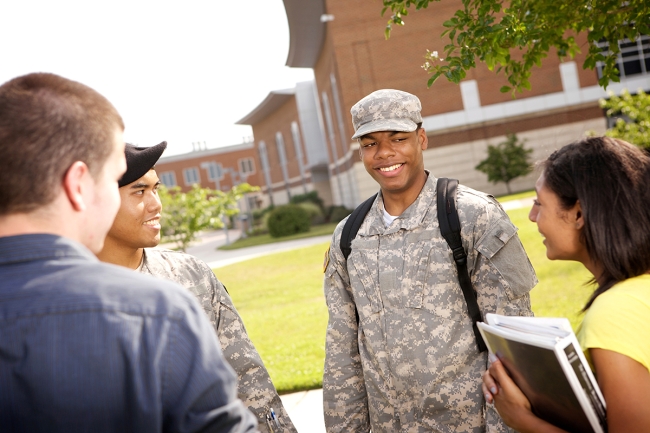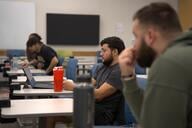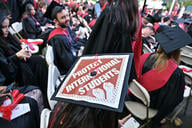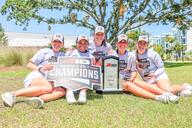You have /5 articles left.
Sign up for a free account or log in.

Staff members at the University of Texas at San Antonio shared retention strategies that support military-affiliated students in their college journey.
Carlos Franco/Getty Images
The University of Texas at San Antonio is nationally recognized as a top college for student veterans, so staff members shared some of their best practices in supporting student retention and completion in a Nov. 13 webinar hosted by the National Association for Colleges and Employers.
Setting the scene: The city of San Antonio is home to the largest base in the Department of Defense, Joint Base San Antonio, which is home to 70,000 service members.
According to fall 2023 data, there were 5,000 military-affiliated students attending UTSA, around 16 percent of the total campus population. Of those learners, over 1,500 were active duty or student veterans, and an additional 290 were Army or Air Force ROTC.
Most military-affiliated students are nontraditional students, with the average being 33 years old, and a majority are nonwhite, married or previously married, employed and living off-campus. Two-thirds of military-affiliated students at UTSA are first-generation, as well.
The university is also staffed by a significant number of veterans, including the two webinar speakers. In fall 2019, 259 faculty and staff identified as veterans.
Serving service members: Six promising practices that UTSA employs for student veterans include:
- Offering a one-stop shop. The Center for Military Affiliated Students (CMAS) is a centralized office that connects resources and services for student veterans and others using military benefits to fund their education. This co-location allows decisions to be made faster and reduce confusion in finding solutions for students, says Michael Logan, senior director of veteran and military affairs at UTSA.
- Supporting transfer. Many military-affiliated students come in with transfer credits from their military service, community college experience or other institutions depending on where they were stationed, said Courtney Pletcher, senior career consultant at UTSA. Helping reduce administrative barriers to process transfer can aid in student retention.
- Providing financial aid information. The Post–9/11 GI Bill is finite and only provides educational benefits for up to 3 months for eligible service members and veterans, which can create challenges for students, as few are able to complete a four-year degree in that time. Timely communication can help make students aware of their benefits exhaustion, and staff work to ensure there are other resources to support student completion.
Lesson Learned
UTSA staff learned that sometimes outside entities would reach out to the university to fund scholarships to support student veterans, but ensuring these scholarships are not tuition-specific guarantees students reap the most benefits from the financial support. Federal military benefits are not refunded to the student if their tuition is covered in other ways, so the scholarship dollars are not used in the most impactful way if these students are already receiving tuition assistance.
Instead, outside financial aid should be broader, allowing the student to apply funding to other expenses beyond tuition.
- Building a sense of belonging. During the COVID-19 pandemic, UTSA launched Operation Buddy Check, a collaboration between the Veteran and Military Affairs office and the veterans’ affinity group Rowdy Warrior Veteran Military Alliance. Volunteers called veterans to offer support, connect them to institutional resources and ensure students felt cared for by the institution.
- Creating peer relationships. CMAS includes a lounge where students can study or hang out, allowing for peers to meet in an informal setting, as well as formal peer-to-peer support.
- Translating skills. Student veterans come to higher education with impactful learning from their time in the service, but helping them transition to civilian life and gain perspective on their transferrable skills can be one area where they need support. When meeting with students, Pletcher reminds veterans they’re not starting from zero but have a wealth of experience.
Understanding veterans: In serving military-affiliated students, Logan and Pletcher identified some areas for practitioners to be aware of:
- Equity and inclusion. Often, veterans can be stereotyped in ways that are harmful to the larger military-affiliated population. Pletcher, as a Navy veteran, has faced challenges in accessing resources from Veterans Affairs because people assumed she wasn’t a service member. Recognizing that veterans are diverse and represent a variety of backgrounds is key to reaching them.
- Military service worldview. In 2019, Logan conducted research on student veterans at UTSA and found—through a qualitative survey with a 54 percent response rate—students hold a similar worldview that ties back to their military service. Subsequent surveys across annual cohorts found similar trends across demographic groups. “Military service is a culture, a shared experience that influences how you see things, perceive things, believe things,” Logan said.
What’s next: The university will continue to conduct research on veteran retention and graduation rates to understand barriers and trends in their experiences.
UTSA received funds to build a new veterans’ center on campus. A small portion of funding is going to the physical development of the center, Logan said. Most dollars are focused on accessibility in the physical space (such as accessible doors, parking and other mobility concerns) as well as ensuring the center’s website is ADA compliant.




